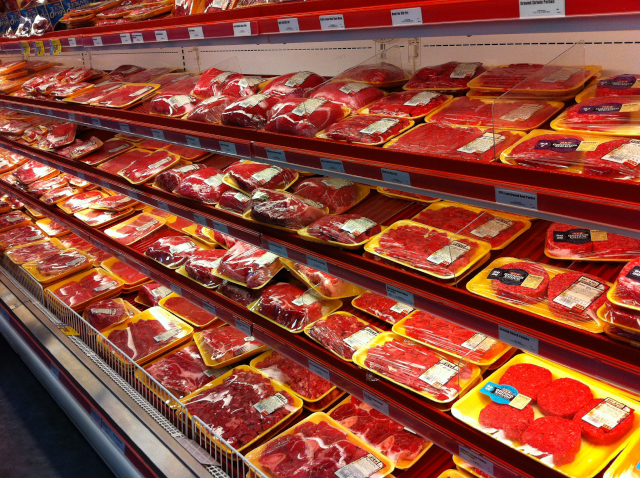A new study of more than 16,000 Americans has produced some startling statistics suggesting that folks across the developed world could decrease their carbon and water use footprints dramatically – simply by cutting beef out of their diets. But how big an impact is it, really?
 The beef display at a typical local supermarket: Go see it while it’s still there…
The beef display at a typical local supermarket: Go see it while it’s still there…
Choose chicken or turkey, the experts suggest, to replace beef in your diet. I blinked several times in a row when I read that one in five survey respondents reported eating at least one serving of beef a day, but the shock didn’t last long. That’s just one in five, after all. And even if some of them eat more than one swerving, it’s not that much. Right?
Anyway, the researchers went on to extrapolate that one less serving of beef per person per day would translate to a reduction of 48 percent in the greenhouse gasses beef eaters produce each day as a result of their diets. And a further 30 percent decrease in water use impact.
Beef targeted as arch enviro-villain
Beef, because of the environmental costs involved with raising it (versus the nutritional value that results), has long been reviled as the single most dangerous agricultural product on the planet. Compared to other livestock types, it is. By far. Furthermore, the researchers point out that the total agricultural activity on earth accounts for about 25 percent of global greenhouse gas emissions and 70 percent of total fresh water use. And the study’s findings are expressed as percentages of those base figures.
I get confused by statistics
The study numbers certainly sound impressive. But what do they really mean?
Take the estimate that we could collectively produce a 30 percent reduction in the amount of water we use to produce beef. Sounds like a noble initiative. But other sources tell us that only 8 percent of total world water usage goes to grow feed crops for all types of meat production. Sure, cows drink a lot of water. But let’s not forget that water goes round and round in an eternal cycle of purification and renewal. The problem is that, these days, in some places, more water is being used than the cycle can renew over a given period of time. What can we do about that?
What about greenhouse gas emissions? The UN Food and Agriculture Organization reports that production of all livestock combined is responsible for only 18 percent of total global greenhouse gas emissions.
If you look at the survey numbers in isolation, which is a common error on the part of folks trying to understand statistics, it sounds like we should all consider it our solemn social duty to drop beef in favour of less-destructive meats – or cut to the chase and go vegan all together.
Alas for the survey folks and their theories, the big picture tells a different, more realistic tale.
Other factors have greater enviro-impact
If the goal behind the survey is to encourage people to swap beef out of their diets, we need to look at the big picture again. When we do, it quickly becomes clear that other factors may have a far more profound impact than beef agriculture. Maybe we should be thinking about buying our first electric car, accelerating clean energy programs, or how to stop countries like China from burning billions of tonnes of coal every year to power their desperate, forced economic development program.
Beef is pricing itself out of the market anyway
Then, there’s the skyrocketing cost of producing beef, and the effect that’s having on retail prices. Beef has already priced itself out of the market for most folks I know. Just as a random example, the weekly flyer of the leading supermarket (consistently claiming ‘the best meat prices’) in my neighbourhood is advertising strip loin steaks at $16 per pound / $35.25 per kg. It would cost at least $30 to feed a family of 4. And that doesn’t account for the veggies, bread and condiments. And contrast that economic picture with centre-cut pork loin chops on the same page of the flyer at $5.49 lb. / $12.10 kg. Or Chicken on the weekly features page of the flyer at $11 for 8 large boneless, skinless chicken thighs or 3 breasts. The ad says they’re air chilled, not pumped full of water, so shrinkage would be at a minimum – an even better value!
One more plug for going plant-based
Even the most persnickety critics are slowly coming around to accepting plant-based meat substitutes. And the products are constantly getting better, with each new release. All that needs to happen now is for the production economics of plant-based foods to catch up with the strong consumer interest, dropping retail prices to the point that they’re competitive with or even cheaper than ‘real’ meat.
And beef will drop off out of our diets naturally, all by itself.
Muse on that…
~ Maggie J.

